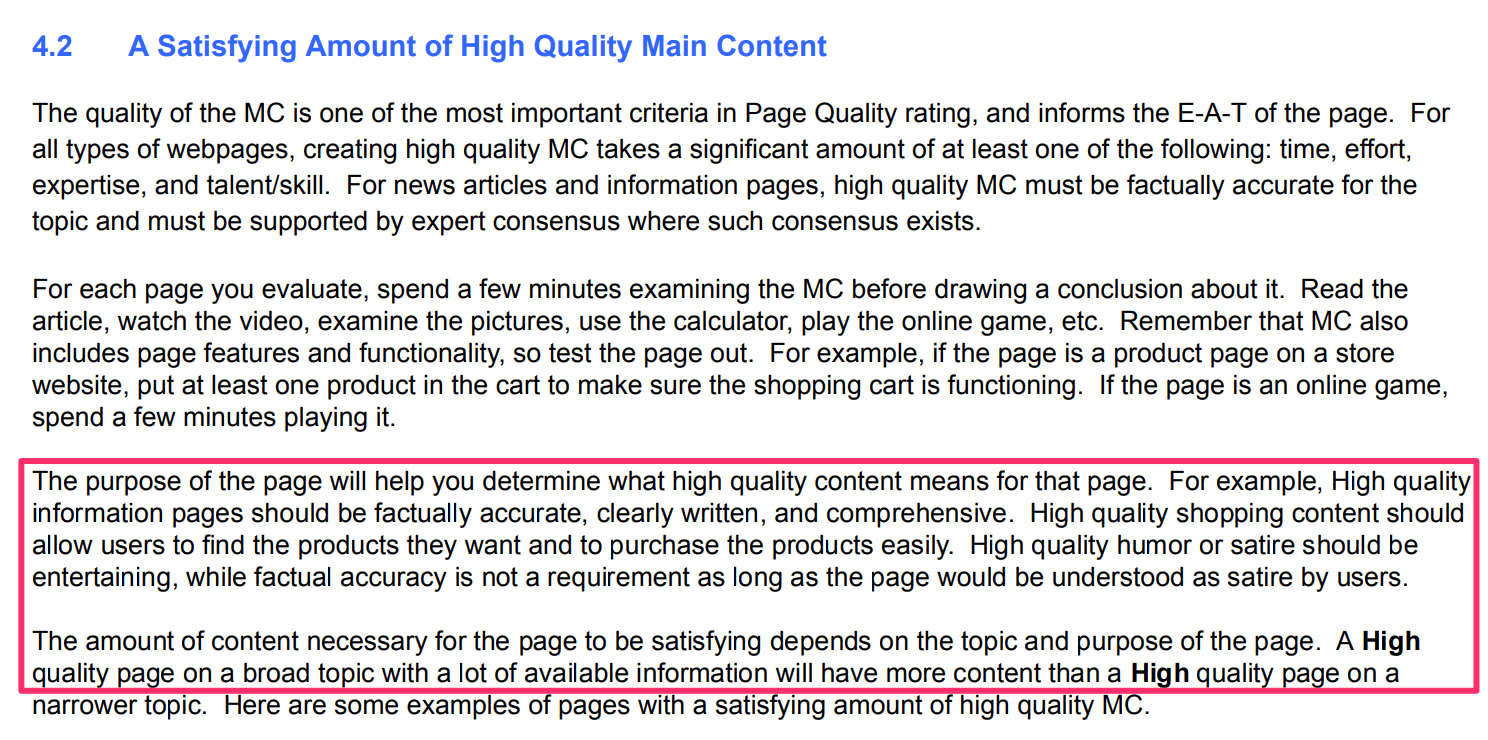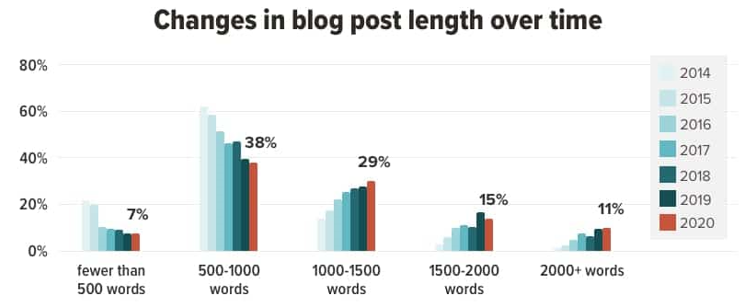Content is the driving force behind a successful SEO campaign. With the booming online marketing trends, blogging and posting relevant content is the fastest way to gain visibility of your brand and drive traffic to the site. Quality content has become an integral part of a digital marketing practice and has a major influence on the site’s search engine ranking.
The most common dilemma faced by content creators and bloggers is to decide the length of a Blog Post. In this post, we will delve into how long should a Blog Post be and the importance of content length for SEO.
Page Contents:
Why the Blog Post length matters?
A higher word count makes it easy for Google to understand what the content is all about. One major benefit of longer articles is that it makes visitors stay longer on the site which in turn, improves the page visibility and builds credibility.
Also, in a longer post, you can include primary keywords, synonyms, and related keywords multiple times without breaking the text fluency. However, article length does not always correlate with the post ranking on the SERPs. In order for a Blog Post to rank higher, it should include comprehensive details of the search query as well as create interest and engagement for the readers.
As per Google guidelines, the amount of content necessary for the page to be satisfying depends on the topic and purpose of the page. The best Blog Post length may vary for different kinds of post category and industry. Blog Post can be categorized into – Long posts and Short posts.
Long Posts vs Short Posts
A common dilemma between content creators and bloggers is to make a choice between short-form and long-form content. Both these content types have their own place in the content marketing realm. Selecting the right medium requires an in-depth analysis of your business objectives, target audience groups, preferred communication format, etc.
Before deciding how long a post should be, it is important to understand the difference between Long and Short Blog Posts.
Long Blog Posts are in-depth posts of more than 1000 words providing detailed information on the blog topic. This content format is especially useful if you want to educate and inform the customers and provide extensive information about the products and services. Long Blog Posts are created to spread brand awareness, build trustworthy client relations and establish deeper customer engagement.
Benefits of creating Longer Blog posts
- Insert more keywords: Long-form content makes it easy to include primary keywords into the content in a seamless manner. Therefore, you can incorporate more keywords into a long Blog Post and improve your search engine ranking.
- Get backlinks: A well-researched, detailed content consisting of infographics and other statistics data has a better chance of obtaining backlinks from high-authority websites.
- High engagement: Long Blog Posts have better engagement rates than short posts. As longer posts takes more time to read, a site visitor will spend more time on your site thereby improving the website bounce rate.
- Brand recognition: Publishing well-researched, high-quality, detailed blog posts establishes your authority and credibility in your business niche. It greatly helps in showcasing your brand as a trusted source of valuable information.
- Builds trust: Long-form content allows a brand to build mutual trust persuading your prospects to make a purchase. Moreover, it helps in connecting directly with the target audience thereby converting visitors into loyal clients.
Short Blog Posts usually range between 300 to 600 words and mainly focus on a specific blog topic. It is used for conveying information in a brief and concise format. Such type of content is commonly useful when you are interacting with your existing customer base and just need to communicate the necessary details.
Benefits of creating short blog posts
- Easy readability: Short-form content enables your target group to read the information on-the-go thereby builds greater engagement with the audience. This works best for communicating with the readers directly and ensures broader reach to a diverse group.
- Time-saving medium: Creating short Blog Posts is time-saving as compared to long Blog Posts. You can publish multiple short Blog Posts in the same time that is required to create a single long post. As short Blog Posts requires less investment of time and resources, it has become a preferred channel for quick and effective communication across a wider group.
- Better reader engagement: It is easy to capture reader’s attention via short-form content than a lengthy Blog Post. Creating such posts allows instant connectivity with the target group thereby driving more traffic to the landing pages.
- Mobile-friendly channel: Another major benefit of a short Blog Post is that it is convenient to read on a mobile phone and can be read on-the-go. As almost every person has access to a smart phone nowadays, creating short posts allows fastest reach directly to the cell phone.
- Increased content shareability: Short posts get more shares on social media platforms than long Blog Posts. As short posts require less time for writing, editing and publishing, you can easily share numerous short posts and expand your content outreach.
The decision to choose between long and short Blog Posts depends on your company goals, communication methodology and marketing objectives. Some other factors which help in determining how long should a Blog Post be are competitors’ analysis, user intent and target group location. You can also take the help of an SERP checker tool online to get accurate guidelines and suggestions on the right content length for your Blog Post.
Factors determining Blog Post length
Adding irrelevant details just for the sake of increasing the word count may adversely affect your post ranking in the SERPs. The ideal Blog Post length depends on various factors. Some of the common parameters that can help in determining the blog length include the topic of the post, target audience, search intent, etc. Above all, the quality of your content and the value it offers to the users are the key elements of a well-written Blog Post.
Factors that should be considered when deciding the ideal Blog Post length are:
Type of Post: Length of a post also depends on its type. Not every post has to be longer in length. The post length depends largely on the industry you are in, the blog topics, and its relevance. In case of a news blog, you need to present news in a succinct and concise manner.
Adding unnecessary details to a news blog dissolves it purpose and reduces the readability. Similarly, blog posts related to product descriptions and reviews require a detailed and in-depth explanation. Hence, a blog length should synchronize with its objective and purpose and must be relevant with the post category.
Content Quality: Content quality always outweighs the quantity. With the aim of delivering the best possible information on the intended search query, you can not only win customer’s attention but also increase your chances of ranking at the topmost position in the SERPs. By creating a high-quality content that is valuable, engaging and informative, you put your content in a stronger position to rank higher in the Google results.
Target Audience: One of the best ways to determine the best Blog Post length is identifying your focus audience. You can divide your audience base into separate categories such as existing clients, new customers, potential clients, etc.
So, instead of calculating the Blog Post length, focus on crafting content that is meaningful for your target audience and helps them find answers to their problems. It is vital to study your target audience and cater to their requirements while drafting a piece of content. As long as you are adding value to the user experience, number of visitors and site rank will continue to spiral.
User intent: The content should satisfy user intent. The key to rank at the top of a search engine result page is to understand the search intent of the users and create reader-centric content that matches their requirements.
A Blog Post must not be written to cover a certain word limit but it should aim to offer complete details and solve the user’s search query. The posts that best matches the search intent and provide accurate details for the search query get displayed at the top of the Google search results.
How to find ideal length for your Blog Post?
To find the perfect content length for your Blog Post, you can conduct analysis of your competitor sites and keywords based on specific user intent. This can greatly help in evaluating your posts and improving them to be on a par with the competitors.
1. Analyze competitor’s sites: Enter the keyword you want to rank for in the Google search. Check the displayed results that match with your user intent and note their word count. Take the average of all the results to get the average Blog Post length.
2. Take the help of SERP checker tools: If the above step is time-consuming for you, then you can opt for a SERP checker tool. It monitors your website, studies the competitor sites and generates results for the best Blog Post length specific to your industry and business niche.
How Serpok helps in Blog Post length suggestion?
The sole purpose of a Blog Post is to maximize user experience by providing best possible answers for their search query. There is no definite word count or word limit for creating a Blog Post. The objective is to contribute knowledge to the readers, help them find relevant answers to their queries and deliver value. An ideal Blog Post length should be as long as it solves the readers’ quest.
Google Algorithms are constantly being updated to improve the search experience aiming to provide greater value to the end user. Hence, an optimal post length would be the one that explores the blog topic, provides accurate information that is helpful to the readers.
Serpok is Google SERP checker tool that makes it easy for your site to rank higher in the SERPs. It conducts in-depth analysis of your blog length and evaluates its content based on the industry competition and user intent.
Moreover, it provides insights regarding the ideal Blog Post length, generates different keyword suggestions related to your topic and niche that can help you optimize the Blog Post in a hassle-free way. Opt for Serpok services to take your content marketing strategy to the next level and drive more traffic. Sign up and explore.
Also you can check: How to Optimize a Blog Post

